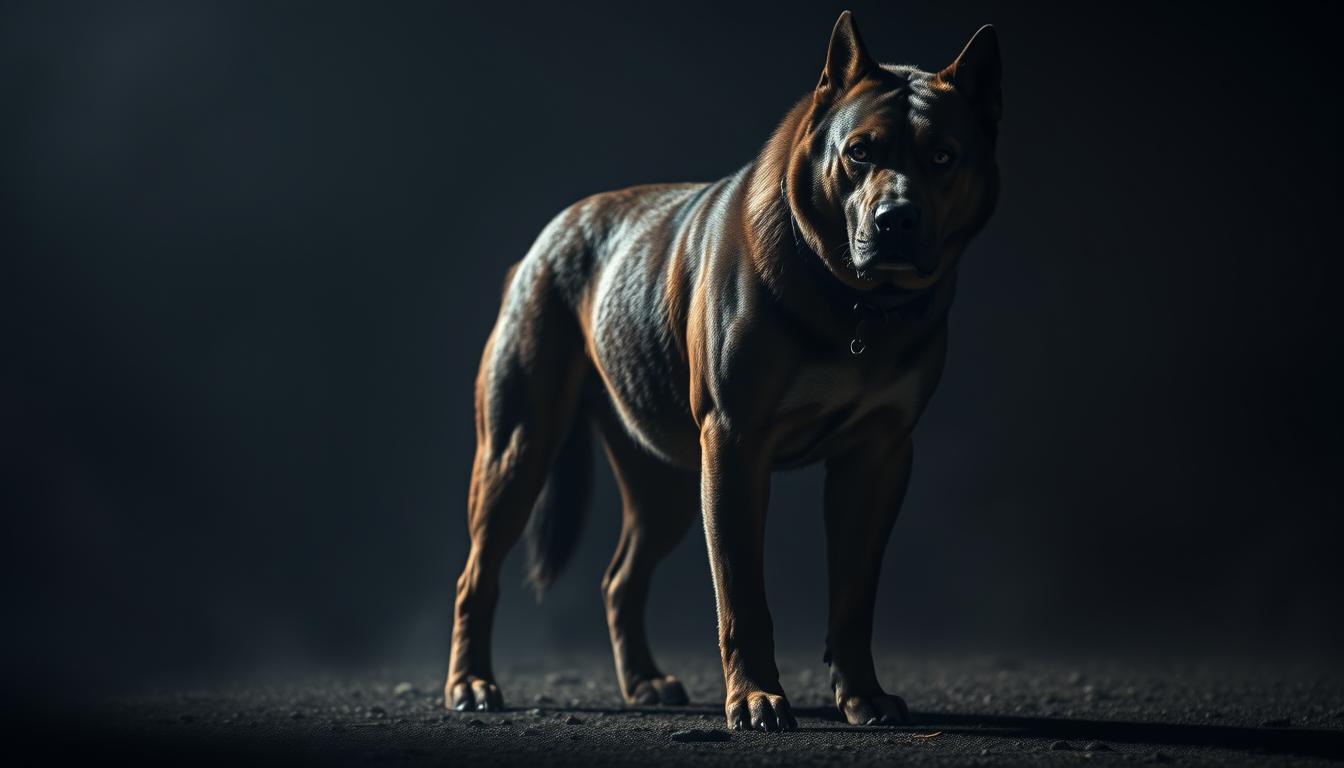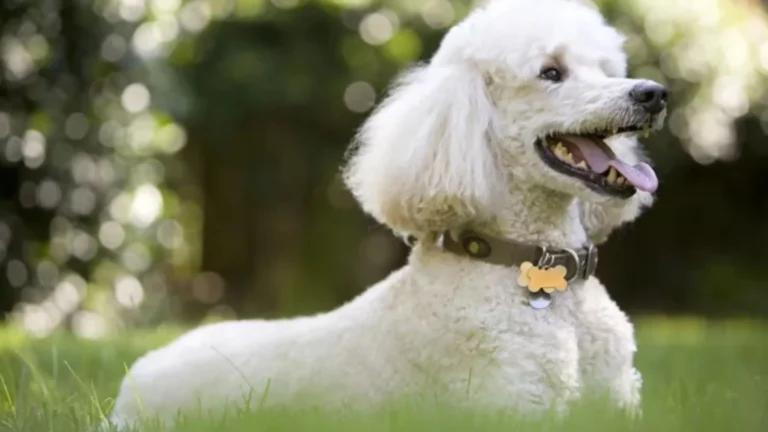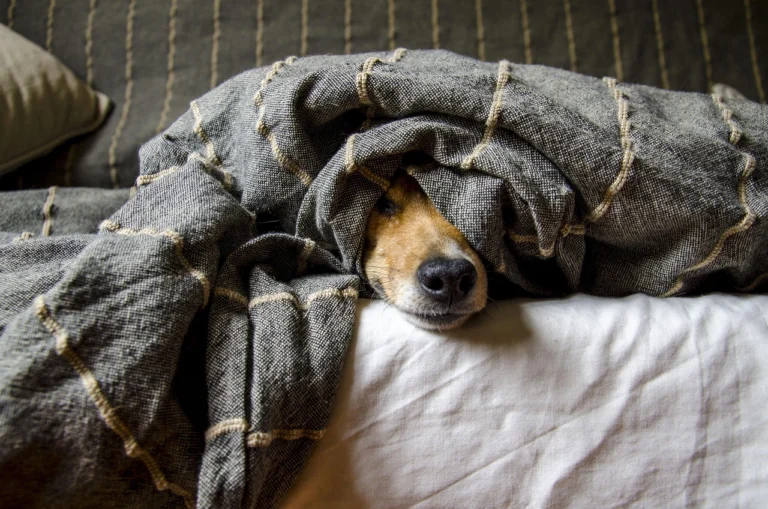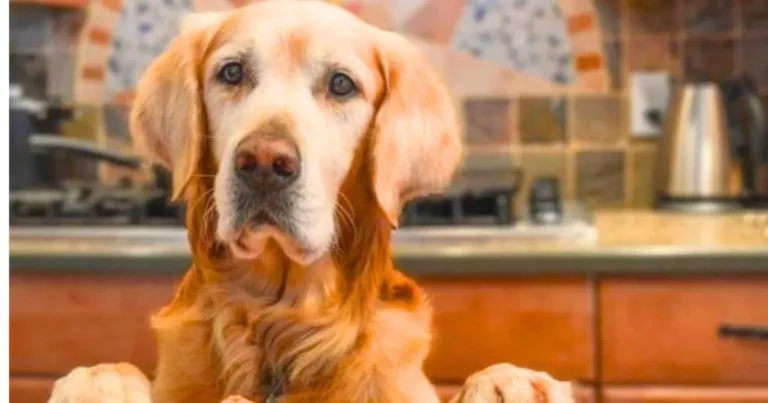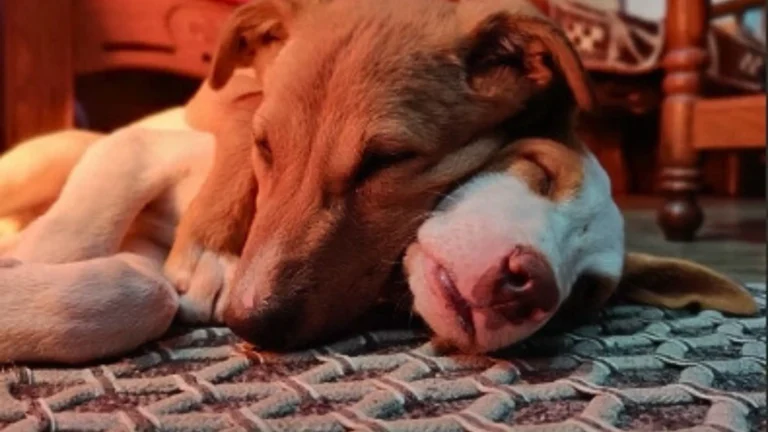Big Scary Dog Breeds: Protective but Loyal Companions
When I first met Max, a massive Rottweiler with deep brown eyes, I realized big scary dog breeds are more than their looks. They’re not just tough protectors—they’re also loving companions who bond deeply with their families.
Dogs have been our guardians for thousands of years. They’ve protected us in ancient times and in our homes today. Their presence doesn’t just scare off threats—it also gives us a sense of safety that’s more than just physical strength.
These amazing animals are more than their big bodies. They have big hearts and are incredibly loyal. Each one has its own personality, ready to switch from fierce protector to loving family member in an instant.
Choosing a guard dog is more than just about security. It’s about welcoming a loyal friend who will be there for you no matter what. These breeds bring strength, smarts, and deep emotional connections to your home.
Table of Contents
Understanding Giant Guard Dog Characteristics
Powerful guard dogs are more than just big and scary. They have special traits that make them great protectors. Knowing about these traits helps people decide if they want a guard dog for their family and home.
Guard dogs have unique qualities that make them stand out. They are naturally protective, acting as a shield for their families.
Physical Traits of Protective Breeds
The best guard dogs have certain physical features:
- Muscular build with strong bones
- Heavy weight, usually 80-150 pounds
- Strong jaw and powerful bite
- Broad chest and athletic build
Natural Guarding Instincts
Largest aggressive breeds have a natural instinct to protect. They learn to spot threats and defend their territory over time.
Intelligence and Trainability Factors
Guard dogs need more than just strength. Mental sharpness is key to their success:
- Quick to spot threats
- Knows when to act and when not to
- Responds well to training
- Has high emotional intelligence
Good training turns powerful guard dogs into loyal and smart companions. They learn to protect in a smart way.
History and Evolution of Protective Dog Breeds
The history of fearsome protection dogs goes back thousands of years. These dogs came from human needs for safety and security. Ancient people saw how important these dogs were for survival.
Early protective breeds were bred for different reasons. Shepherds in mountains needed strong dogs to protect their animals. Nobles wanted dogs that looked fierce and showed their wealth.
- Mesopotamian cultures developed early guardian breeds
- Roman legions used massive dogs for military protection
- European farmers created specialized working dogs
Humans bred these dogs to have certain traits. They wanted dogs that were strong, smart, and loyal. These traits made them great protectors of homes and families.
The relationship between humans and protective dogs represents a profound partnership of mutual trust and protection.
Today, breeding continues to improve these dogs. They keep their protective nature but also make good family pets. This balance makes them valuable in both roles.
Learning about their history helps us see how these dogs have grown with humans. They have always been loyal guardians, even as the world has changed.
Most Popular Big Scary Dog Breeds Today
When looking for big, scary dogs, many people choose iconic breeds. These dogs are strong, smart, and loyal. They make great family pets, offering both protection and friendship.
Today’s protective dog breeds are more than just big and scary. They have amazing skills, are very smart, and always stand by their families.
German Shepherds: Military and Police Guardians
German Shepherds are known for their incredible work skills. They have a long history in military and police work. This makes them top choices for protection.
- Exceptional intelligence and trainability
- Strong protective instincts
- Versatile working abilities
- Loyal family companions
Doberman Pinschers: Elite Protection Specialists
Doberman Pinschers are among the most refined watchdog breeds. They were bred for personal protection. These dogs are fast, smart, and very alert.
| Characteristic | Doberman Traits |
|---|---|
| Size | Large and muscular |
| Temperament | Alert and fearless |
| Training Potential | Extremely high |
| Family Compatibility | Excellent with proper socialization |
Rottweilers: Ancient Guardians with Modern Appeal
Rottweilers come from ancient Roman working dogs. These powerful canines have evolved from cattle drovers to family protectors. They are strong and reliable.
If you want a loyal family guardian or a loving companion, these breeds are perfect. They offer unmatched protection and friendship.
Giant Mastiff Varieties for Protection
Mastiff varieties are top picks for big scary dog breeds. They are known for being powerful guard dogs. These dogs have a long history of protecting families and homes with their size and loyalty.
There are many amazing mastiff breeds, each with its own special traits for protection:
- Cane Corso: An Italian breed known for muscular build and intense protective instincts
- Tibetan Mastiff: Ancient guardian with thick fur and territorial nature
- English Mastiff: Gentle giants with tremendous strength and calm demeanor
Choosing a mastiff depends on your protection needs and home. These dogs need lots of space, regular training, and owners who get them. They have complex personalities.
| Mastiff Breed | Size Range | Protection Level | Temperament |
|---|---|---|---|
| Cane Corso | 88-110 lbs | High | Protective, Intelligent |
| Tibetan Mastiff | 70-150 lbs | Very High | Independent, Vigilant |
| English Mastiff | 120-230 lbs | Moderate | Gentle, Loyal |
Remember that these big scary dog breeds need lots of socialization and professional training. They can become great family protectors.
Eastern European Guardian Breeds
Eastern Europe is home to some of the world’s most impressive giant intimidating canines. These largest aggressive breeds have unique traits that make them stand out as guardians. Their history and powerful build set them apart from other protective dog breeds.
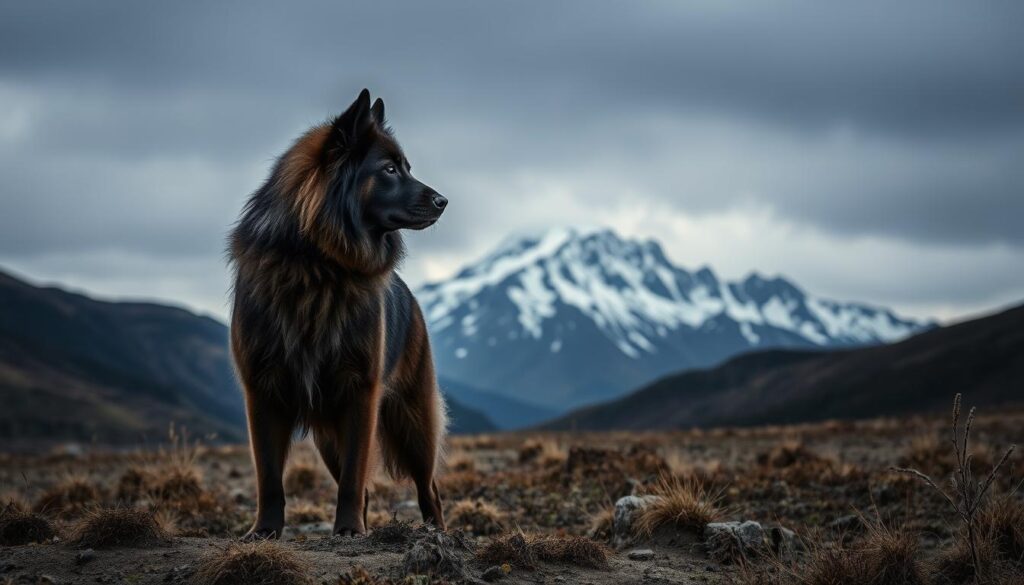
The harsh climates and historical challenges in the region have shaped these working dogs. They are now resilient and formidable protectors. Each breed has distinct traits that reflect their origins and traditional roles.
Caucasian Shepherd Dogs
Caucasian Shepherd Dogs are at the top of guardian breed development. Originating in the mountainous regions between Europe and Asia, they were bred to protect livestock from predators. Their size and fearless nature make them among the most impressive guardians.
- Weight range: 100-200 pounds
- Height: 23-30 inches at shoulder
- Primary protective instincts: Territorial defense
Black Russian Terriers
Black Russian Terriers were developed by Soviet military researchers. These giant intimidating canines were bred for military and security work. They are disciplined protectors.
“A Black Russian Terrier is not just a dog, but a living fortress with exceptional intelligence and loyalty.” – Canine Breed Specialists
Central Asian Shepherd Dogs
Central Asian Shepherd Dogs are incredibly adaptable. They have survived extreme conditions, developing unmatched protective abilities.
| Breed Characteristic | Description |
|---|---|
| Origin | Central Asian Steppes |
| Primary Function | Livestock Protection |
| Temperament | Independent, Courageous |
To understand these Eastern European guardian breeds, we must appreciate their complex backgrounds and abilities. They are impressive but need experienced handlers for proper training and socialization.
Training and Socializing Powerful Guard Dogs
Training fearsome protection dogs needs patience and a smart plan. These dogs must learn to be good family guardians. With the right training, they can become loving and loyal pets.
Start training early, say dog trainers. Begin socializing your dog when they’re a puppy. This helps them grow up balanced and learn good behavior.
- Begin obedience training at 8-12 weeks old
- Expose the dog to various people, animals, and environments
- Use positive reinforcement techniques
- Establish clear boundaries and consistent commands
Here are some key training methods for fearsome protection dogs:
| Training Method | Purpose | Key Benefits |
|---|---|---|
| Socialization | Reduce aggressive tendencies | Calm temperament |
| Obedience Training | Establish control | Predictable behavior |
| Boundary Setting | Define protection zones | Targeted guardian skills |
Professional training is key to making dangerous dogs into reliable protectors. Keep training your dog to keep their skills sharp and behaviors positive.
“A well-trained protection dog is a family’s greatest asset and most loyal companion.” – Professional K9 Trainer
Investing in thorough training makes your guard dog a trusted and loving family member. They will protect you without being too aggressive.
Health Considerations for Large Protective Breeds
Big scary dog breeds need special care to keep them healthy and strong. These massive dogs have unique health needs. Owners must pay close attention to their health.
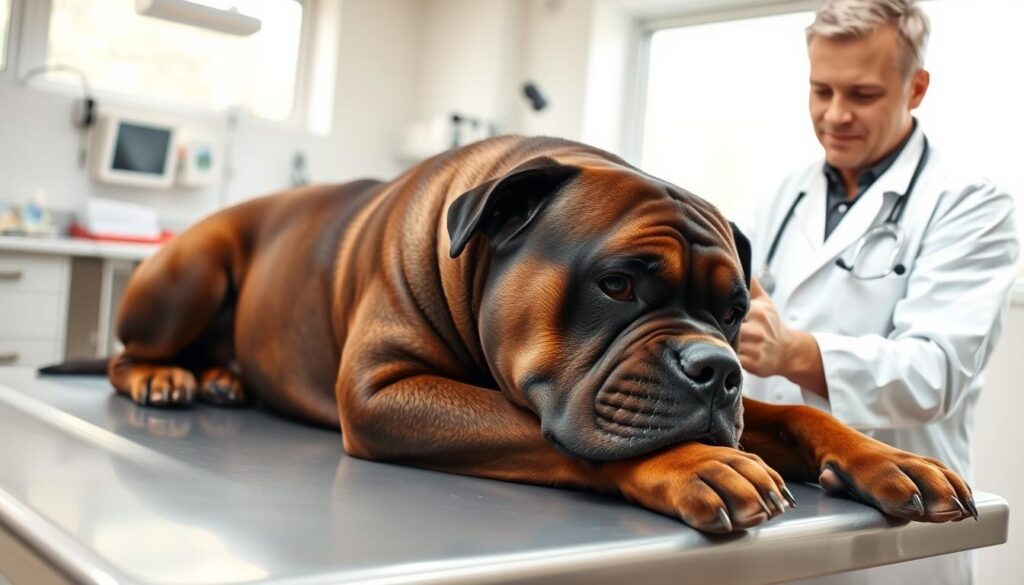
Knowing the health challenges of these dogs is key. It helps keep them as strong and healthy protectors.
Common Medical Challenges
Large protective dog breeds face many health issues. These include:
- Hip dysplasia
- Elbow joint problems
- Cardiac concerns
- Bloat and gastric complications
Nutritional Strategies
Feeding big scary dog breeds needs careful planning. Their size requires a balanced diet for health.
| Age Group | Daily Calorie Intake | Protein Requirement |
|---|---|---|
| Puppy | 2500-3500 calories | 22-32% |
| Adult | 1800-2500 calories | 18-25% |
| Senior | 1500-2000 calories | 15-20% |
Exercise and Wellness
Massive threatening canines need regular exercise and mental stimulation. This prevents obesity and keeps their joints healthy.
- Daily walks (45-60 minutes)
- Strength training
- Mental stimulation activities
- Regular veterinary check-ups
Proactive healthcare ensures these magnificent guardians remain strong, healthy companions for years to come.
Living with Big Scary Dog Breeds
Bringing big scary dog breeds into your home needs careful thought and dedication. These dogs are not just tough protectors. They are also loyal family members who need extra care and attention.
Space is very important when you have large protective dogs. You’ll need lots of room inside and outside for them to move freely. Here are some important things to consider:
- Dedicated indoor sleeping area
- Secure outdoor space for exercise
- Room for training and socialization
- Sufficient storage for specialized equipment
Thinking about money is also key with these big dogs. You’ll spend more on:
- Premium high-protein dog food
- Larger veterinary expenses
- Specialized training programs
- Potential home insurance adjustments
Teaching your dogs to control their protective instincts is crucial. Socialization from an early age helps prevent aggressive behaviors. It makes sure your dog knows how to act with family and visitors.
The key to success with large protective breeds is building mutual trust and respect.
By understanding and meeting their needs, you can turn these impressive dogs into loving family members.
Conclusion
Big scary dog breeds are a mix of strength and loyalty. They are more than just tough guards; they are complex friends that need understanding and care. Owning one means you must think about training, socializing, and knowing the breed well.
Choosing a big scary dog is more than picking a pet. It’s welcoming a smart guardian into your family. Success comes from knowing they need training, leadership, and love. They can be fierce protectors and loving friends with the right owner.
These amazing dogs have a special side. They may look scary, but they can be gentle and loving with the right care. By training them well and understanding their nature, they become incredible friends.
Big scary dog breeds offer a special chance for a deep bond. They bring protection, loyalty, and security to your home. With the right approach, you can see their true potential and enjoy a remarkable relationship.
FAQ
Are big scary dog breeds suitable for families with children?
How much exercise do giant guard dog breeds typically need?
What are the typical food costs for large protective dog breeds?
Do these breeds require special housing or living conditions?
Are these breeds difficult to train?
What are the typical health challenges for big scary dog breeds?
How expensive are these dog breeds to purchase and maintain?
Are big scary dog breeds suitable for families with children?
How much exercise do giant guard dog breeds typically need?
What are the typical food costs for large protective dog breeds?
Do these breeds require special housing or living conditions?
Are these breeds difficult to train?
What are the typical health challenges for big scary dog breeds?
How expensive are these dog breeds to purchase and maintain?
FAQ
Are big scary dog breeds suitable for families with children?
Yes, big scary dog breeds can be great for families with kids. But, they need lots of training and socialization. This ensures they behave well around children.
Breeds like German Shepherds and Rottweilers can be gentle and protective. They need consistent training and responsible care.
How much exercise do giant guard dog breeds typically need?
Giant guard dog breeds need a lot of exercise, about 60-90 minutes a day. They need walks, playtime, and training to stay healthy.
Without enough exercise, they might get destructive or anxious.
What are the typical food costs for large protective dog breeds?
Feeding a large protective dog can be pricey. Monthly costs range from to 0. This depends on the dog’s size, age, and diet needs.
Big breeds like Mastiffs need high-quality, protein-rich food.
Do these breeds require special housing or living conditions?
Yes, they need a lot of space. They don’t fit well in small apartments. They need homes with:
– Lots of indoor space
– Secure, fenced outdoor areas
– Room to move and exercise
– Comfortable resting areas for their size
Are these breeds difficult to train?
No, they’re smart and can be trained. But, they need consistent, patient training. Breeds like German Shepherds and Doberman Pinschers respond well to positive training.
Professional training is often a good idea, especially for new owners.
What are the typical health challenges for big scary dog breeds?
They face health issues like hip and elbow dysplasia, bloat, and joint problems. Heart issues and genetic concerns are also common.
Regular vet visits, proper diet, and exercise can help prevent these problems.
How expensive are these dog breeds to purchase and maintain?
Buying a big scary dog can cost between
FAQ
Are big scary dog breeds suitable for families with children?
Yes, big scary dog breeds can be great for families with kids. But, they need lots of training and socialization. This ensures they behave well around children.
Breeds like German Shepherds and Rottweilers can be gentle and protective. They need consistent training and responsible care.
How much exercise do giant guard dog breeds typically need?
Giant guard dog breeds need a lot of exercise, about 60-90 minutes a day. They need walks, playtime, and training to stay healthy.
Without enough exercise, they might get destructive or anxious.
What are the typical food costs for large protective dog breeds?
Feeding a large protective dog can be pricey. Monthly costs range from $80 to $250. This depends on the dog’s size, age, and diet needs.
Big breeds like Mastiffs need high-quality, protein-rich food.
Do these breeds require special housing or living conditions?
Yes, they need a lot of space. They don’t fit well in small apartments. They need homes with:
– Lots of indoor space
– Secure, fenced outdoor areas
– Room to move and exercise
– Comfortable resting areas for their size
Are these breeds difficult to train?
No, they’re smart and can be trained. But, they need consistent, patient training. Breeds like German Shepherds and Doberman Pinschers respond well to positive training.
Professional training is often a good idea, especially for new owners.
What are the typical health challenges for big scary dog breeds?
They face health issues like hip and elbow dysplasia, bloat, and joint problems. Heart issues and genetic concerns are also common.
Regular vet visits, proper diet, and exercise can help prevent these problems.
How expensive are these dog breeds to purchase and maintain?
Buying a big scary dog can cost between $1,500 to $8,000. Ongoing costs include:
– High-quality food
– Veterinary care
– Training
– Insurance
– Equipment and supplies
Total annual costs can be over $2,000-$3,000.
Are these dogs good for first-time dog owners?
No, they’re not ideal for first-time owners. They need advanced training, consistent leadership, and a lot of time. They also require understanding of their specific needs.
Experienced owners or those willing to invest in training are better suited.
,500 to ,000. Ongoing costs include:
– High-quality food
– Veterinary care
– Training
– Insurance
– Equipment and supplies
Total annual costs can be over ,000-,000.
Are these dogs good for first-time dog owners?
No, they’re not ideal for first-time owners. They need advanced training, consistent leadership, and a lot of time. They also require understanding of their specific needs.
Experienced owners or those willing to invest in training are better suited.

